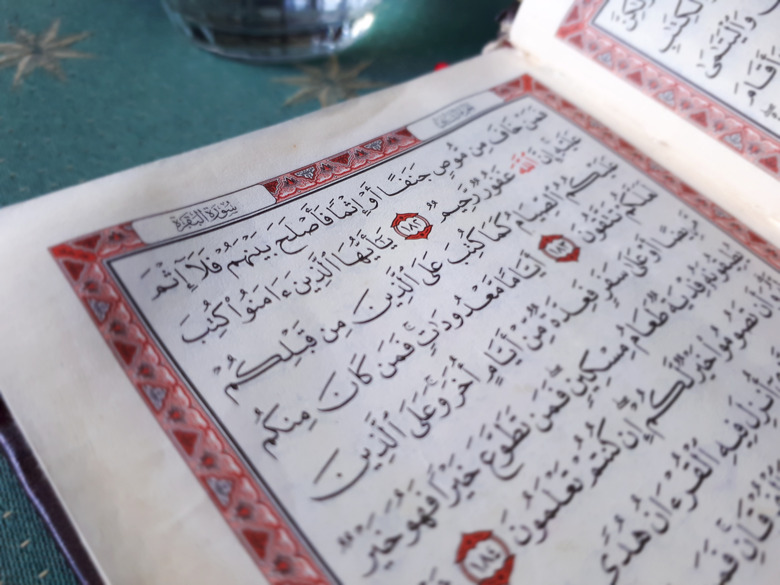The Impact Of Islam On World Society
Islam has had a profound global impact since it was founded in the seventh century. During what is known as the Golden Age of Islam, which lasted roughly between the mid-eighth century until the 13th century, the Muslim world was the center of intellectual activity, with Baghdad serving as the capital for philosophers, mathematicians and scientists. Mathematics, language, astronomy and medicine were particularly influenced by this culture and its effects can still be seen to this day.
Mathematics
Mathematics
Although the numbers we use today were developed in India and were originally called "Hindu numerals," the symbolic system was spread across the Middle East by mathematician al-Khwarazmi and has come to be known as "Arabic numerals." al-Khwarazmi also authored several important books on math, one of which includes various ways to solve quadratic equations using both words and letters to represent numerical values, a common practice today. The transliteration of his name, in fact, is Algorithmi, which is the origin of the term "algorithm." The word "algebra" is derived from the Arabic word al-jabr, meaning to restore or complete.
Language
Language
Like most languages, Arabic has spread throughout the world by way of trade and conquest. The Moors of North Africa, who invaded Spain in 711 and were not completely expelled until 1492, left a distinct mark on the Spanish language. Because the Muslim world was the center of philosophy, science, mathematics and other fields for most of the medieval period, many Arabic ideas and concepts were spread across Europe, and trade and travel through the region made understanding Arabic an essential skill for merchants and travelers alike. As a result, modern English includes Arabic-based words such as "admiral" from "amir-ar-ahl," meaning chief of the transport; "sequin" derived from "sikkah," a die used for coinmaking; and "jar" from "jarrah," a large earthen vase.
Astronomy
Astronomy
Because of the requirement to face Mecca during daily prayers, Muslims needed an accurate way to determine their exact geographic location, so Muslim scientists found a solution through astronomical research. Initially attacked as astrologers, false soothsayers who used the night sky to divine the future, astronomers eventually found favor when the religious establishment determined that science could demonstrate the complexity of Allah's (God's) creation. Freed by this new perspective and aided by translations of Greek scientific works (especially the writings of Ptolemy), Muslim astronomers made many important discoveries using various tools, including quadrants and even observatories. Ibn al-Shatir developed the planetary theory and studied the radius of Mercury's orbit, information that would be crucial to Copernicus' work 150 years later. Planetary movements were closely charted, and Islam's Golden Age of science was so thorough in its findings that even today two-thirds of the known stars have Arabic names. Unfortunately, many scientific discoveries were lost when Baghdad was invaded and sacked by Mongol forces.
Medicine
Medicine
Persian intellectual Ibn Sina (980-1037), known as Avicenna in the West, made great contributions to philosophy, mathematics and especially medicine. His Arabic book "The Canon of Medicine" was so influential that it was used by doctors and students of medicine for hundreds of years. In it he describes how to properly quarantine patients to avoid spreading illness, and he provides criteria for properly testing new medicine. During the medieval period, Muslim doctors were the first to use antimony (a metalloid) for its medicinal powers. Hospitals were developed during the Islamic Golden Age and surgical practices, shunned by other societies, were further explored and refined in the Muslim world. Even Islam's ritual ablution before prayer led to advances in hygiene.
Cite This Article
MLA
Maldonado, Jose. "The Impact Of Islam On World Society" sciencing.com, https://www.sciencing.com/the-impact-of-islam-on-world-society-12087149/. 26 June 2018.
APA
Maldonado, Jose. (2018, June 26). The Impact Of Islam On World Society. sciencing.com. Retrieved from https://www.sciencing.com/the-impact-of-islam-on-world-society-12087149/
Chicago
Maldonado, Jose. The Impact Of Islam On World Society last modified March 24, 2022. https://www.sciencing.com/the-impact-of-islam-on-world-society-12087149/
